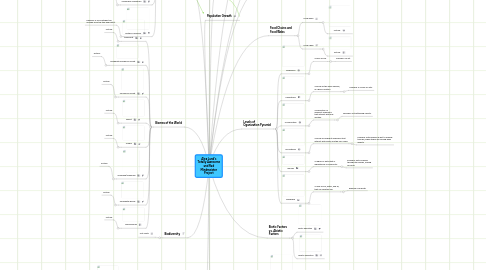
1. Trophic Levels
1.1. Producer
1.1.1. Example: A tree uses photosynthesis to get energy from the Sun.
1.2. Primary Consumer
1.2.1. Example: A ladybug eats a leaf of the tree for its food.
1.3. Secondary Consumers
1.3.1. Example: A monkey eats the ladybug as its prey.
1.4. Tertiary Consumer
1.4.1. Example: A lion snatches the monkey from the tree and eats it.
2. Biomes of the World
2.1. Rainforest
2.1.1. Picture:
2.2. Temperate Deciduous Forest
2.2.1. Picture:
2.3. Coniferous Forest
2.3.1. Picture:
2.4. Desert
2.4.1. Picture:
2.5. Tundra
2.5.1. Picture:
2.6. Grassland/Savannah
2.6.1. Picture:
2.7. Freshwater Biome
2.7.1. Picture:
2.8. Marine Biome
2.8.1. Picture:
3. Biodiversity
3.1. Hot Spots
4. Ecological Succession
4.1. Basic Types of Succession
4.1.1. Primary Succession
4.1.1.1. Example:
4.1.2. Secondary Succession
4.1.2.1. Example:
4.2. Pioneer Species
4.2.1. Picture:
4.3. Climax Community
4.3.1. Picture:
5. Limiting Factors
6. Population Growth
7. Levels of Oganization Pyramid
7.1. Organisms
7.1.1. A form of life.
7.1.1.1. Example: An ant
7.2. Populations
7.2.1. A group of the same species, in a given location.
7.2.1.1. Example: A colony of ants.
7.3. Communities
7.3.1. A population of different organisms that interact with one another.
7.3.1.1. Example: Ants attacking insects.
7.4. Ecosystems
7.4.1. A group of different organisms that interact with living, and the non-living.
7.4.1.1. Example: Ants picking up dirt to arrange their hill, while others are moving dead insects.
7.5. Biomes
7.5.1. A region of Earth that is inhabited by a community.
7.5.1.1. Example: Ants climbing through the woods, looking for food.
7.6. Biosphere
7.6.1. A layer of soil, water, and air, that can substain life.
7.6.1.1. Example: The Earth.
8. Food Chains and Food Webs
8.1. Food Webs
8.1.1. Picture:
8.2. Food Chain
8.2.1. Picture:
9. Biotic Factors vs. Abiotic Factors
9.1. Biotic Definition
9.2. Abiotic Definition
10. Carrying Capacity
11. Exponential Growth
11.1. Sustainability
11.1.1. Logistic growth
11.1.1.1. Hold Backs
11.1.1.1.1. Black Plague
11.1.1.2. Increases
11.1.1.2.1. Industrial Growth
12. The Curves
12.1. J-curve
12.2. S-curve
13. Population Growth Rate
14. Water Pollution
14.1. The Points
14.1.1. Point Source Pollution
14.1.2. Non-Point Source Pollution
